The Cole-Hackenberger (Gray) Power Supply
An analysis of the working principle behind this device.

By Arend Lammertink, MScEE. November, 2015.
Introduction
In 1973, Edwin Gray patented a Pulsed Capacitor Discharge Electric Engine, an engine which could produce quite a lot of power seemingly coming out of nowhere. Needless to say, such an engine would change the world, but for various reasons the engine never made it to the market. Over the years, quite a lot of information on these engines has been gathered by Mark McKay, who a/o published an article on the Evolution of the E.V. Gray Circuit Topology in 2004. And even most if not all of the prototypes have resurfaced, although these have been severely damaged in the 1980s. Most of these prototypes have been made by Richard Hackenberger, the technician hired by Edwin Gray to develop this technology, after Marvin Cole, who made the first prototype, left the scene.

E.V. Gray Version 2.0 type Motor EMA6 1977
Over the years, many people have investigated this technology, which included a/o a rather strange tubes, which were replaced by Ignitrons and/or Thyratrons in later Hackenberger prototypes:.
Unfortunately, because the spark gap the device employed (to tap radiant energy) caused serious radio and communications interference, the Federal Communications Commission ordered him to stop.
He then pursued a different design that used capacitor discharging through an ignitron switch. Part of the problem in coming up with a plausible design is that the original inventor, Marvin Cole, was no longer on the scene.
This strongly suggests that this strange tube must have been a triggered spark gap, or better: triggered arc. Interesting detail is that arcs have a negative resistance area of operation, which can be used to build oscillators, which include radio transmitters. The Poulsen arc radio transmitter, for example, was widely used until the 1920s. If the coils within the engine were indeed part of the tank circuit of a spark gap (arc) oscillator, then it should be no surprise this technology has not been successfully replicated to date.
However, Mark McKay recently brought to my attention that besides these highly complex engine prototypes, Richard Hackenberger also developed a solid state version of the power supply system. Stand alone versions of this power supply have also been demonstrated by Gray, powering an impressive load of over 1 kW, even including a TV-set. In the course of a technical discussion about this with Mark, I came to the conclusion that the power supply unit is essentially a dual solid state Bedini "schoolgirl" oscillator, whereby Hackenberger found an elegant solution to the problem of effectively utilizing the energy John Bedini refers to as "radiant energy", these characteristic BEMF spikes we see in John's systems.
Since Richard Hackenberger and Marvin Cole were the real inventors of this technology, I'd like to refer to this system as the "Cole/Hackenberger Power Supply" (CHPS). Before we discuss the schematics and details of the CHPS, we shall first take a look at the theory and the mechanisms which make this technology possible. At the Energetic Forum, we dubbed this mechanism the "electret effect".
The discovery of the electret effect
My investigation of these kinds of technologies began at the energetic forum, where I joined in 2008. In December 2009, I noted that the similarities between John Bedini's "cold boiling batteries" and Stan Meyer's technology were striking:
"All in all, I think both are using the same energy source: the super-polarized dielectricum and that is which is apparently able to provide excess energy."
Aaron Murakami commented:
"I have showed this for years. Imhotep even mentioned it about a cap that seems to not be able to die because it keeps itself charged up like an electret - from a conditioning effect. Anyway, there is something to it."
"The "boiling" effect isn't necessarily unwanted when charging batteries with the Bedini method. They will COLD boil, even up to an hour after the charger is disconnected if using for example, high capacitance low voltage discharges."
Without going into details, we can conclude that there is at least one known practical way to create batteries and electrolytic capacitors which charge themselves for a certain amount of time without any (visible) external power being fed to the system. As a side effect when using batteries, highly explosive hydrogen gas is released, which is called "cold boiling", which introduces hazardous situations. Fortunately, the electrolytes used in electrolytic capacitors prevent hydrogen gas to be released, so these are much safer to work with. You really don't want to be near an exploding (lead acid) battery.
Contrary to most other types of capacitors, the dielectric material which is responsible for most of a capacitors capacity in an electrolytic capacitor does not fill up all the space between the metal plates of the capacitor. Electrolytic capacitors are made by growing a very thin layer of a dielectric material, a material that can be polarized, on one of the metal capacitor plates. The other "plate" is formed by ions in the electrolyte, which fills up most of the space between the metal plates. The other metal plate is merely a contact plate.
One can actually make electrolytic capacitors quite easily at home and do some experiments, using the recipe of Nyle Steiner. One can also make electrolytic rectifiers, as radio amateurs did in the old days, which are very similar to home made electrolytic capacitors. What is very interesting is that these produce a visible glow during operation:

As stated above, it is possible to bring such an electrolytic capacitor into a state that it becomes self-charging, by applying a characteristic "spike" signal to it's terminals. These spikes have a very fast rising edge and a slow falling edge and look like this on an oscilloscope:
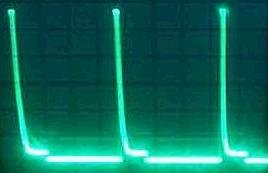
In order to understand how this is possible, we first need to know what Porarization of a dielectric material is:
In classical electromagnetism, polarization density (or electric polarization, or simply polarization) is the vector field that expresses the density of permanent or induced electric dipole moments in a dielectric material. When a dielectric is placed in an external electric field, its molecules gain electric dipole moment and the dielectric is said to be polarized.
[...]
An external electric field that is applied to a dielectric material, causes a displacement of bound charged elements. These are elements which are bound to molecules and are not free to move around the material. Positive charged elements are displaced in the direction of the field, and negative charged elements are displaced opposite to the direction of the field. The molecules may remain neutral in charge, yet an electric dipole moment forms.
The interesting detail about the dielectric material within (electrolytic) capacitors is that this polarization is not instantaneous. The (dipole)molecules within a dielectric cannot keep up with a rapidly changing electric field and thus lag behind. This causes the well known Dielectric absorption effect:
Dielectric absorption is the name given to the effect by which a capacitor, that has been charged for a long time, discharges only incompletely when briefly discharged. Although an ideal capacitor would remain at zero volts after being discharged, real capacitors will develop a small voltage from time-delayed dipole discharging, a phenomenon that is also called dielectric relaxation, "soakage", or "battery action". For some dielectrics, such as many polymer films, the resulting voltage may be less than 1–2% of the original voltage, but it can be as much as 15% for electrolytic capacitors.
[...]
Dielectric absorption is a property which has been long known. Its value can be measured in accordance with the IEC/EN 60384-1 standard. The capacitor shall be charged at the DC voltage rating for 60 minutes. Then the capacitor shall be disconnected from the power source and shall be discharged for 10 s. The voltage regained on the capacitor terminals (recovery voltage) within 15 minutes is the dielectric absorption voltage.
Such a measurement is shown in the following video:
http://www.youtube.com/watch?v=vhHog_yCQ4Q
According to the table on the above page, Aluminium electrolytic capacitors with non-solid electrolyte show the highest absorption, between 10 and 15%. This is important to note, because Aluminum electrolytic capacitors will likely work the best in a CHPS.
On the same page, we find some theory:
Charging a capacitor (due to a voltage between the capacitor plates) causes an electric field to be applied to the dielectric between the electrodes. This field exerts a torque on the molecular dipoles, causing the directions of the dipole moments to align with the field direction. This change in the molecular dipoles is called oriented polarization and also causes heat to be generated, resulting in dielectric losses (see dissipation factor). The orientation of the dipoles does not follow the electric field synchronously, but is delayed by a time constant that depends on the material. This delay corresponds to a hysteresis response of the polarization to the external field.
When the capacitor is discharging, the strength of the electric field is decreasing and the common orientation of the molecular dipoles is returning to an undirected state in a process of relaxation. Due to the hysteresis, at the zero point of the electric field, a material-dependent number of molecular dipoles are still polarized along the field direction without a measurable voltage appearing at the terminals of the capacitor. This is like an electrical remanence. The oriented dipoles will be discharged spontaneously over time and the voltage at the electrodes of the capacitor will decay exponentially. The complete discharge time of all dipoles can be days to weeks depending on the material. This "reloaded" voltage can be retained for months, even in electrolytic capacitors, caused by the high insulation resistance in common modern capacitor dielectrics. The discharge of a capacitor and the subsequent reloading can be repeated several times.
Note that the polarization of the dielectric is proportional to the applied electric field and not to the applied current c.q. charge. So, what happens when we momentarily apply a strong electric field to the dielectric so that it polarizes, without actually charging the capacitor by applying a charge current ourselves?
Now wouldn't that be a nice trick to make this Dielectric absorption phenomenon "reload" our capacitor, such that it is the dielectric which charges our capacitor?
Well, that's exactly what can be done by applying these characteristic "Bedini" spikes to an electrolytic capacitor. Peter Lindemann and Aaron Murakami describe this as follows in their Intermediate Bedini SG Handbook:
When an appropriate dielectric material is used in a capacitor that is charged from the energy of an inductive collapse, the electrostatic component of this type of electricity produces a "temporary electret effect" in the capacitor. Exactly how well this effect is established and how long it persists depends on the material used as the dielectric.
They also describe that when adding a capacitor charge and discharge (buffer) section to their circuit their battery charges better and faster:
[E]very time we discharge the capacitor into the battery to charge it, the capacitor is refilled, partially from the coil discharges, and partially from the "temporary electret effect" in the capacitor itself. This phenomena is definitely an energy gain in the system and the appearance of electricity that did not come from the run battery in any way that can be measured on today's meters.
This clearly establishes the theoretical basis for the observed performance of the machine. The second battery charges better and faster when the capacitor charge and discharge section is added to the circuit, in spite of the measurable losses associated with the switching process.
So, while both batteries and electrolytic capacitors can show this "self charging" "electret effect" behavior, this effect is apparently stronger in electrolytic capacitors than in batteries.
However, while this effect has been shown to work in practice, it puts a theoretical problem in front of us: The Law of conservation of energy.
As it turns out, a static electric field can provide energy without breaking the law of conservation of energy. This is explained in detail in the excellent theoretical research of the German Professor Claus Turtur, who also proved his thesis experimentally by showing that the electric field within a high voltage plate capacitor can indeed do work without drawing any current from it's power supply:
http://www.youtube.com/watch?v=IiC2IGLl90Q
In his paper, Prof. Turtur, explains how energy is being converted from Zero-Point Energy into available electric field energy, which can therefore be utilized without breaking the law of conservation of energy.
For a practical analogy, just think of a polarized dielectric material as being kind of a solar panel. A kind of solar panel that does not operate on light (energy) but on zero-point energy. A kind of solar panel that does not provide electric current, but an electric field. An electric field, which can be used to charge an electrolytic capacitor.
In other words: when the right kind of signals are applied to an electrolytic capacitor, it can be thought of as a kind of solar panel which converts zero-point energy into usable electric energy.
So far the basic theory. Let's continue by taking a closer look at John Bedini's technology, who spent years on researching and documenting this phenomenon.
John Bedini's methods
On the website of Panacea-BOCAF, there is a whole page on John Bedini, which includes the following introduction:
John Bedini is the founder of Bedini Electronics. John is a developer of electrical amplifiers and a very vigorous FREE energy engineer. John has also done research into the suppressed alternative cancer cure work of Raymond Rife. Most of John’s free energy work is originally inspired and based on the ideas of Nikola Tesla. John has built and demonstrated many advanced free energy principles. The first was completed as far back as the 80's, however getting this type of technology known publicly or into academia has not been possible.
John has altruistically released alternative energy information into the public domain. These disclosures include the "School Girl" or SSG (simplified school girl motor) and Bedini, Cole “Window motor” motor circuits. John’s open public disclosures of the SG concept are intended as an educational tool for the public to observe and test the effects of battery charging by his unique process which has advantages over other methods.
His "School Girl" motor is the basic version of his larger multi coil motors, which demonstrates the principle and can easily be built, for example using a wheel from a bicycle. There are a number of magnets attached to the wheel, which come into proximity with a bifilar (transformer) coil, wound around an iron core:
One of the windings is the power winding, the other one is used as a feedback coil, which steers the transistor such that the circuit oscillates once a magnet on the wheel approaches the coil:
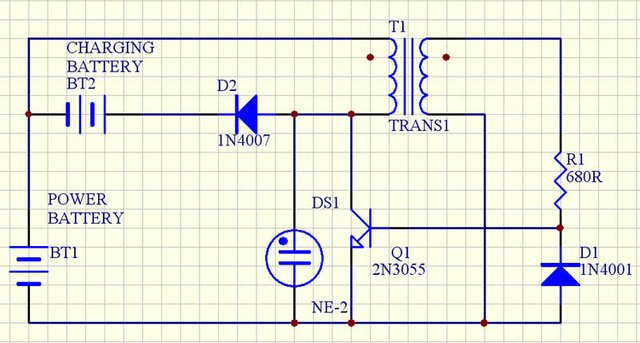
This circuit is very similar to an Armstrong oscillator, which also uses a feedback "tickler" coil for steering the transistor or vacuum tube.
When the transistor switches "off", the magnetic field energy built up in the energized coil needs a way out. This causes this characteristic Back EMF (BEMF) to occur, which discharges trough diode D2 to the charging battery.
It is also possible to operate a similar circuit without the wheel, which is called a solid state Schoolgirl (SSSG) circuit, like this one, which also has multiple power coils:
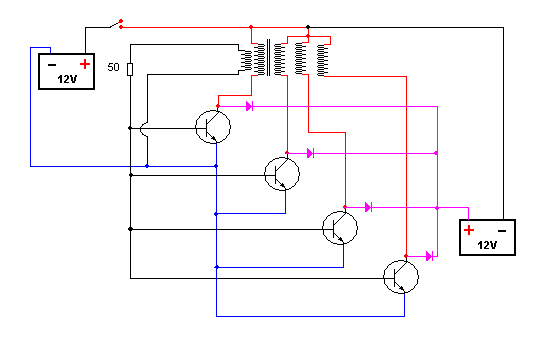
It is also possible to drive the transistor with a separate oscillator, such as a 555 timer circuit, in which case one does not need the feedback coil. In short, there are many ways to create this characteristic "spike" waveform, which all share one important aspect:
The transistor needs to be switched from "on" to "off" as fast as possible.
A lot more information about this can be found in Panacea's overview document, wherein we also find the following note:
A note on Radiant energy From Dr Peter Lindemann
When radiant energy is properly applied to a battery electrolyte, the battery undergoes a series of changes that restores its potential AND lowers its internal impedance. This restores the battery to the condition generally referred to as “charged.” What is so astonishing is that it does this without the need to force the electrons from the positive plate back to the negative plate through an external circuit. Using John’s simple, patented inductively coupled radiant oscillators, and his patented switching techniques, the amount of electricity it takes to produce the radiant energy is very low, and the effect of the radiant energy on the receiving battery is very high. The source battery and the secondary battery being charged are NEVER directly connected to each other. There is no “closed loop!”
John and I have run tests with prototype, solid-state, radiant chargers that draw ONE WATT (12 volts @ 80ma) from the source battery and can charge a 7 amp-hour gel-cell battery from 10.5 volts (fully discharged) up to 14 volts in under one hour (3600 joules). This newly charged battery is then discharged by being connected to a sine-wave inverter and running a 100 watt light bulb for 40 minutes (240,000 joules). After discharge, it can be charged back to full again by the one watt charger in about an hour. The COP of the system is very high. The apparent efficiency of this test is COP>60! Even John and I question the math when it is this high. Never the less, we have run dozens of these tests with the COP>20. Different batteries behave differently with different charger configurations.
Actually, batteries which are charged this way start to behave differently after a while. In fact the chemical substances within the battery appear to change, as has been researched by Dave Rogers:
High Voltage impulse charging as prescribed by John Bedini has been seen to charge a battery cell in a different physical manner. This may explain the positive gains claimed for Bedini impulse systems such as the SSG and in particular the “back popping” setups such as the FEG.*
[...]
Initial Conclusion
HV impulse charging of a lead acid cell produces dendrite growths of probably Lead Tetroxide (red lead) on the Anode, as well as the usual Lead Dioxide dendrites on the cathode.
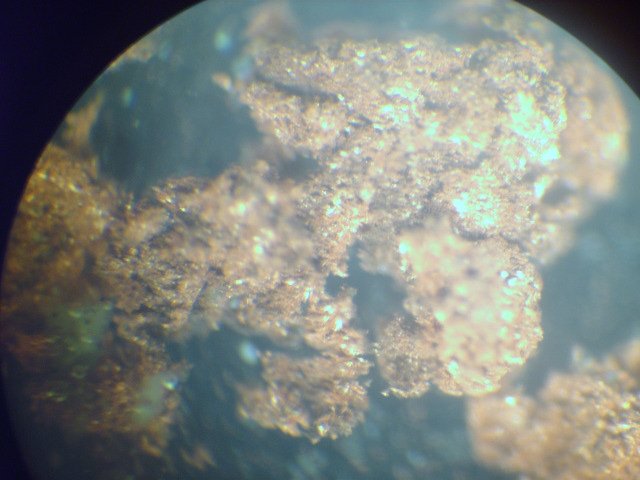
Microscopic close-up of Anode growth. high res
John Bedini and Rick Friedrich also did some experiments with a number of home-made laboratory battery cells:
Note: this video is no longer available on YouTube. On-site copy here.
John Bedini and Rick Friedrich show how some basic batteries are formed with lead and paste and acid. You can see how sulfation occurs on the plates, and how the Bedini charging reduces sulfation and the ruin of the plates. Acid is drained in the one cell and Alum with water is replaced. Two batteries are shown that run just as good with Alum instead of acid.
Peter Lindemann and Aaron Murakami describe an intriguing detail in their Intermediate Bedini SG Handbook about the nature of the energy of these "spikes":
From the very early diagrams to the drawings used in the Beginner's Handbook, we have always shown the capacitor discharge circuit with the switch on the POSITIVE line. Classical electric circuit theory usually leaves the negative or ground lines connected throughout the circuit, and this is where John began his experiments, as well.*
However, when John started to seriously explore the capacitor discharge effects on the battery, he found that leaving the positive lines connected and switching the NEGATIVE line also had merit. After extensive testing, John now switches the NEGATIVE line almost all of the time.*
The new theory that supports this thinking suggests that allowing the high voltage pulses coming from the coil to build up on the capacitor, but also letting them act on the positive terminal of the battery, produces a better result. The theory is that this circuit allows the positive plate of the battery to become "pre-potentialized" even before the current surge released by the switch acts on the chemistry.
This observation clearly illustrates that at this point in our analysis the classical lumped circuit model is no longer valid. What we are dealing with, is a transient phenomenon involving impulses, whereby especially the electric field changes so rapidly that longitudinal electric as well as transverse electromagnetic waves, which propagate at the speed of light, are the dominant phenomena which therefore need to be considered.
Contrary to popular belief, both types of waves propagate trough the medium (the aether) itself and do not need free electrons to be present in order to propagate. In most applications, the presence of these waves can be ignored, except when considering (fast) transient phenomena. In the analysis thereof, one needs to fall back to wave propagation models, such as the Telegrapher's equations. And since it appears that the dominant phenomenon to consider is longitudinal waves, we would need to develop an equivalent for the telegrapher's equations for Tesla's single wire transmission system. So, we would need a transmission line model for a single wire transmission line, which I've worked on some time ago.
I'm not too sure my derivation of the longitudinal distributed inductance is correct, but the idea of considering a distributed series resonant LC circuit for describing the longitudinal wave propagating along a single wire transmission line is the correct approach.
Characteristic for this mode of propagation is that there is no return path for the current. There is no current flowing in circles, because this propagation mode embodies the curl-free half of the Helmholtz decomposition which has been totally ignored in Electromagnetic physics:
A terminology often used in physics refers to the curl-free component of a vector field as the longitudinal component and the divergence-free component as the transverse component.
In a video (probably from the "Energy from the Vacuum" series) John Bedini demonstrates that a neon bulb lights up, when he holds one of it's terminals in his hand and with the other he touches the plastic surface of a battery being charged from his big multi-coil motor. If anything, that makes clear that we are dealing with a situation whereby the classic lumped circuit model is no longer valid and that a strong electric field is present, because the ionization of the gas in a gas-discharge bulb occurs by the presence of a strong electric field.
So, we are looking at a transient electric phenomenon, whereby the BEMF spike we see on the scope has such a steep rising edge that a longitudinal shockwave of possibly enormous magnitude is propagating from the coil to a/o the capacitor and/or battery being "charged", whereby the wires and components from the coil to the capacitor act as a single wire transmission line, whereby the longitudinal shockwave goes trough just about anything, especially any (parasitic) capacitance. However, it does appear to be guided by conductors and probably semiconductors, closed spark gaps (ignitrons), vacuum tubes (thyratrons), etc.
While all of the above does not give us a complete mathematical model of the phenomena at hand, it does give us a rather solid practical foundation which we can build upon. The main problem with Bedini's technology is that John thus far has been unable to "close the loop". However, the power supply c.q. inverter unit developed by Marvin Cole and Richard Hackenberger as part of the EV Gray engine appears to offer a solution to that problem, so let's check it out.
From Bedini to the CHPS
EV Gray and his associates are mostly known for the development of their engine and many researchers have attempted to find out how they managed to realize a COP of no less than 282. A part of this engine was it's power supply, which Hackenberger called the "E.M.S. Inverter":
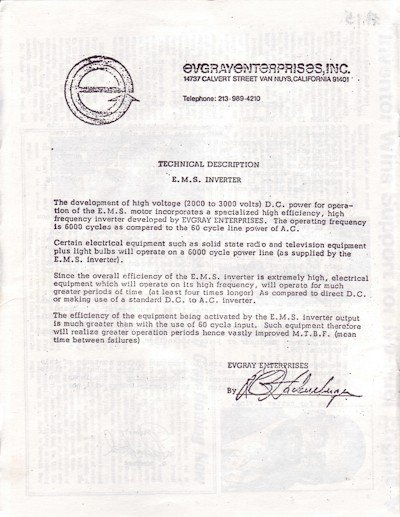
The text reads:
TECHNICAL DESCRIPTION
E.M.S. INVERTER
The development of high voltage (2000 to 3000 volts) D.C. power for operation of the E.M.S. motor incorporates a specialized high efficiency, high frequency inverter developed by EVGRAG ENTERPRISES. The operating frequency is 6000 cycles as compared to the 60 cycle line power or A.C.
Certain electrical equipment such as solid state radio and television equipment plus light bulbs will operate on a 6000 cycle power line (as supplied by the E.M.S. inverter).
Since the overall efficiency of the E.M.S. inverter is extremely high, electrical equipment which will operate on its high frequency, will operate for much greater periods of time (at least four times longer) As compared to direct D.C. or making use of a standard D.C. to A.C. inverter.
The efficiency of the equipment being activated by the E.M.S. inverter output is much greater than with the use of 60 cycle output. Such equipment therefore will realize greater operation periods hence vastly improved M.T.B.F. (mean time between failures)
EVGRAY ENTERPRISES
Signed: Richard Hackenberger.
According to Mark McKay, Hackenberger said a/o the following things about this "box":
This little box (here) is what makes that motor go!
The transformer is the heart of the Generator ---|- it will cost 20% more than a regular transformer, but any fabricator can build it. (From Audio Tapes recovered in 2009 & 2014)
We are feeding it [the load] Chopped DC, and the lower end of the sine wave is going back into the battery again.
One of the secrets is the transformer; it is the only none off-the-shelf component in the whole system.
It is not a full sine wave ---| If you look at a scope it looks like a hay field. High frequency, high amplitude, very narrow spike.
Some features reported by Mark of this 1979 inverter:
Substantial Snubber Network
Negative Bias drive for switching transistors
Fast fall time for transistors <25 ns
Transformer has 3 Primary Taps and 4 Secondary Taps
From Hackenberger's "technical description", we learn that the CHPS operated at a frequency of 6 kHz. While at first glance the description might suggest they are able to run "certain electrical equipment" at high voltages, this is not what is actually being said. But it is clear that an inverter existed, which could be used standalone and which was a solid state device. Possibly the 4 secondary taps could be used to produce several voltages, including about 125, as observed by George Dunford, as reported in Mark's 2014 presentation "The Real History of the Ed Gray Motor", showing:
- a 50% duty cycle square wave
- operating at 6 kHz 125 Volts p-p.
In 2010, one of the last inverters ever built (in 1979) was recovered:
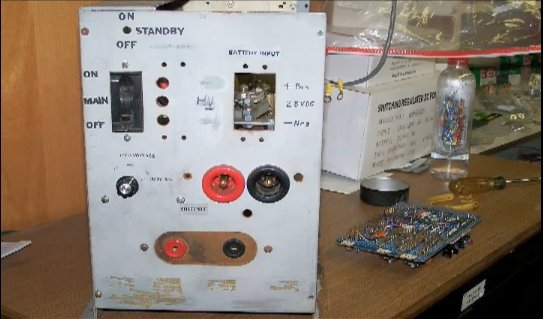
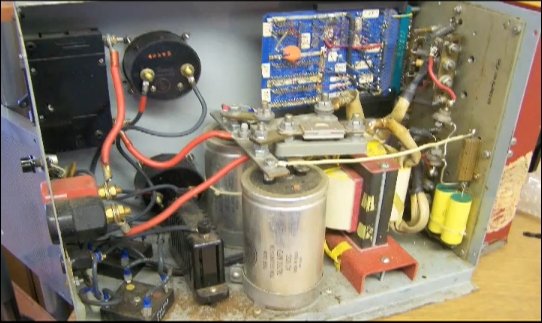
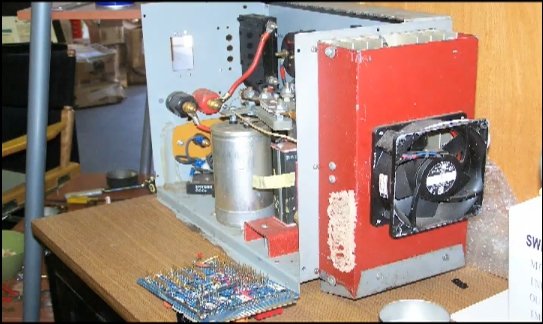
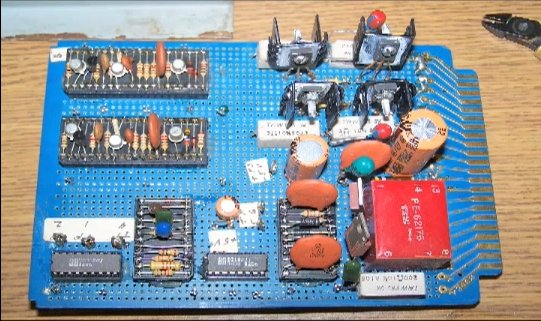
Needless to say, this is an intriguing box, which fascinated Mark. During our e-mail discussion, he mentioned the strange transformer with multiple primaries, which made me remember Matt Jones' paper on the Tesla Switch, which also includes a transformer with two primaries:
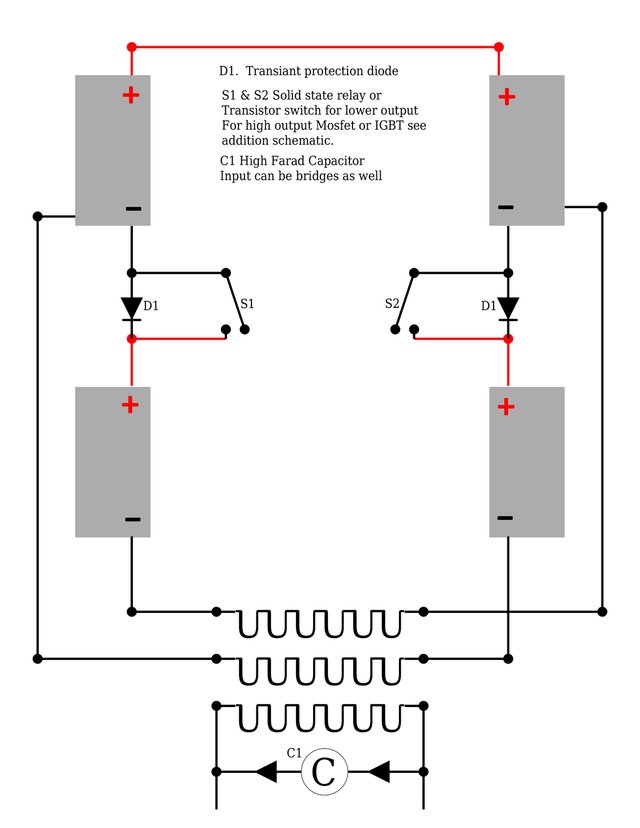
Perhaps the first "Tesla Switch" in the public domain has been built by John Bedini, who did not use a dual primary transformer, but he got his "Cigar-Box Size Tesla Switch" working to be demonstrated at the Tesla Centennial Symposium in Colorado Springs, CO, on August, 11, 1984. I don't remember where I saw or read it, but if memory serves me right John once said that this unit required a lot of tuning, whereby he was looking for those "spikes" to occur on the scope during tuning. So, it is likely that the "Tesla Switch" uses the same principle as described above. Matt Jones also referred to the patents of Carlos Benitez, which can also be found with color enhanced illustrations in Patrick Kelly's Book, Chapter 5. Also, Eric Dollard had a similar device which self-sustained the electrical system his car.
Based on this information, I came to the idea that it might be possible to build an inverter with a Bedini-like driver, as I mailed to Mark:
Creating spikes for inducing this enhanced dielectric absorption effect is easy and it is well documented by Bedini. The problem is how to harness these spikes, because you can't just send them back to your battery/capacitor trough a diode in the case of a single coil, because then you just shortcut the coil. Bedini solved this problem by directing the BEMF spike to a second battery trough a diode.
What is interesting about Matt's work is the use of a transformer with two identical primaries. I think it should be possible to make a Bedini inspired inverter / converter by employing two primaries, which are fed by two batteries or electrolytic capacitors, whereby the BEMF spike from one primary is directed to the other battery/cap. See the following schematic:
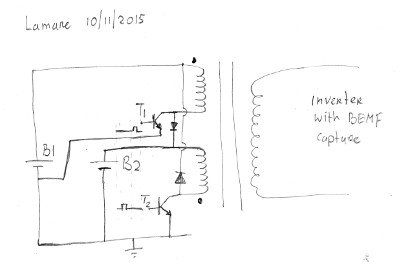
Perhaps the same trick can also be done some way with a tapped primary.
The next day, Mark sent me his schematic from the CHPS, which he painstakingly reconstructed from available photos. It just about blew me away. It was very similar to this sketch, but it included a possible mechanism for "closing the loop" as well as an important detail regarding fast turning off of (bipolar) transistors.
Turning transistors off as fast as possible
In his 2014 presentation "The Real History of the Ed Gray Motor", Mark included his analysis of the control board of the 1979 CHPS unit:
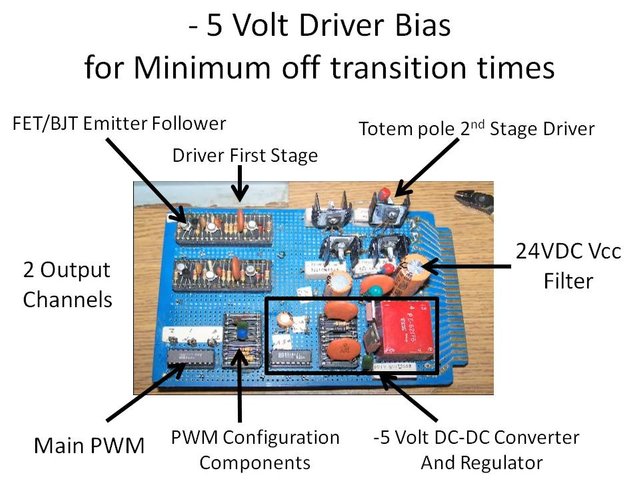
It's not so much the Totem-pole push–pull driver which got my attention, nor the PWM or the first stage driver. It was the -5V DC-DC converter, which was used to provide a -5V bias to the switching transistors in order to minimize the transistor's turn-off times, which is very important to create as strong a BEMF spike as possible. And in order to discharge the base of the transistor as fast as possible, it also makes sense to use a push-pull driver to drive the power transistor.
This technique is not very common, but it is being used in the industry, for example for Fast switch-off of high voltage 4H-SiC npn bipolar junction transistor from deep saturation regime
The switch-off time, $\Delta t_{off}$ , can be made shorter by applying a negative base pulse in the switch-off process.
Quite a lot more information can be found in an STMicroelectronics application note Influence of Gate and Base drive on Power Switch Behaviour:
A negative base-emitter voltage (in the order of the transistor base-emitter breakdown voltage $BV_{EB}$) can be applied in order to reduce the effect of the parasitic base resistor $r_{bb}$ at turn off. This resistor behaves inversely to the turn on phase and limits the extraction current when the base-emitter junction approaches cut-off (see fig. 6).*
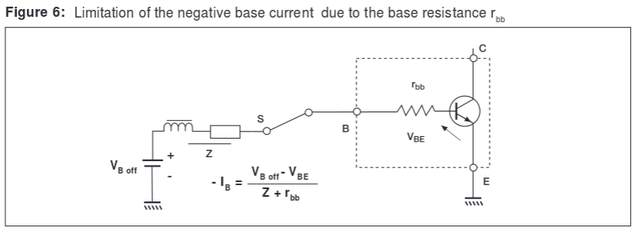
For example a high voltage ETD transistor such as the BUF410 can be turned off with a base-emitter resistance in the order of 0.3 Ohms. In this condition oscillogram 1 shows a fall time $t_f$<100ns. ($I_c$=8A,$T_j$=100°C).
If an negative base-emitter voltage of 2.5 Volts is applied, the fall time is reduced to less than 50ns, see oscillogram 2.
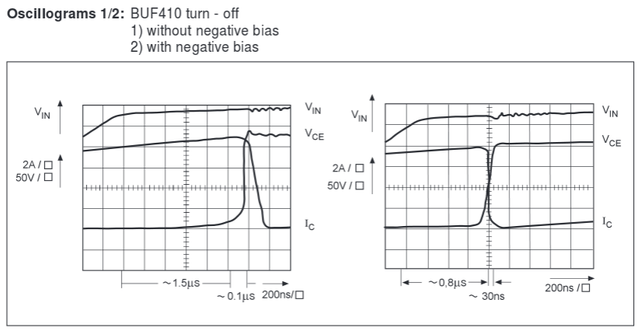
Also some info can be found in Drix' Bipolar FAQ:
Can the base be driven negatively?
Yes, but there is a maximum level that should not be exceeded. The maximum negative base-emitter voltage can be found in the maximum ratings table. Exceeding this value will not immediately destroy the transistor if base current is held to a moderate value, but repeated avalanche base-emitter reverse breakdown may lead to shifts of dopants altering the characteristics of the transistor. In case the transistor base can be driven negatively, make sure the reverse base-emitter voltage is not exceeded, and if there is a risk that this may occur, make sure that the negative voltage is clamped by a protection circuit so that it is not the transistor itself that will need to clamp the negative voltage.
What is the maximum negative base current, and what is it used for?
A transistor with zero base voltage or a negative base voltage will be in cut-off mode. In switching applications the transistor will turn off when it enters cutoff mode. In case the base current is zero during turn off, the transistor will stop conduction by recombination of minority carriers. This may take up to 10µs or so. If the transistor needs to be switched off faster, these carriers can be drawn from the base by applying a negative base voltage. While the transistor is turning off, the base current will be negative. As soon as the transistor is fully off, the negative base current will fall to zero even if the negative drive voltage is sustained.
The maximum negative base current is usually equal to the maximum positive base current.
What is the relationship between base drive and switching characteristics?
For most power devices including BJT's, the drive waveform is of utmost importance. For fast turn on, a rapid rise (high di/dt) of base current is required. Turn off for a BJT is more difficult : to avoid long storage times, it is important not to drive the transistor too deep into saturation, meaning that the on-state base current must be chosen carefully. For fast turn-off, charge must be extracted from the base. The RBSOA will depend highly on the negative base current and the risetime of the negative base drive. Therefore poor base drive may lead to high switching losses and to initiation of 2nd breakdown when switching inductive loads. Many switching transistor breakdowns can be related to poor base drive waveforms.
A way to avoid driving a BJT transistor deep into saturation is to use a Baker clamp circuit:
Baker clamp is a generic name for a class of electronic circuits that reduce the storage time of a switching bipolar junction transistor (BJT) by applying a nonlinear negative feedback through various kinds of diodes. The reason for slow turn-off times of saturated BJTs is the stored charge in the base. It must be removed before the transistor will turn off since the storage time is a limiting factor of using bipolar transistors and IGBTs in fast switching applications. The diode-based Baker clamps prevent the transistor from saturating and thereby accumulating a lot of stored charge.
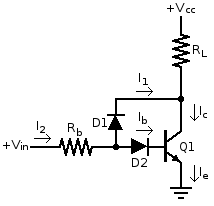
For MOSFET's, there are similar techniques on how to reduce MOSFET turn-off delay:
A MOSFET gate and driver look something like this:
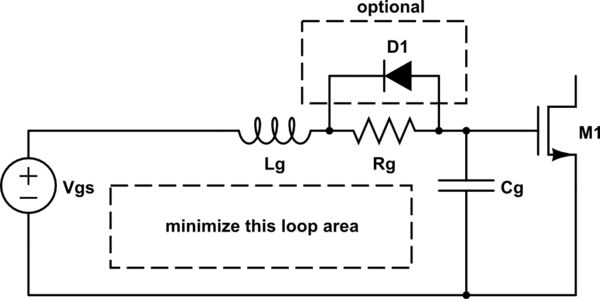
CG is mostly the gate capacitance of the MOSFET itself. The driver may add some capacitance of its own, but it's usually negligible.
LG and RG mostly come from the gate driver circuit. The leads of the MOSFET also contribute, but to a lesser degree.
RG is also expressly added in some driver circuits to dampen the resonance of LG and CG. Without this damping, ringing can result in the voltage at M1's gate taking transient excursions well beyond the voltage provided by VGS, sometimes exceeding the maximum specified by the MOSFET and damaging the gate.
For the fastest possible switching times, you want all of these to be as little as possible.
Minimizing RG is pretty straightforward. Don't add any more resistance than required, and don't make the PCB traces excessively thin. You also want the driver to be as close to the MOSFET as possible, and you want it to be something capable of sinking and sourcing high current. The simplest way to do that might be to add a BJT push-pull pair of emitter followers:
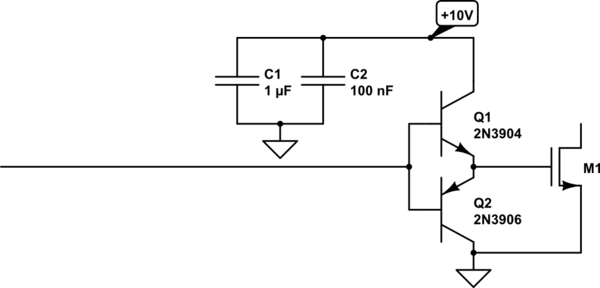
Power semiconductor manufacturer Ixys published an application note "Driving MOSFETs and IGBTs into the 21st Century" (pdf):
In this application note, we will discuss on how to drive MOSFETs and IGBTs for the 21st century. We will discuss its technology, power losses in drivers and driven MOSFET/IGBT and its technology advances. The application note will also discuss the types of drivers and techniques to boost the current outputs*
One of the techniques they describe is the use of negative bias, illustrated in these figures:
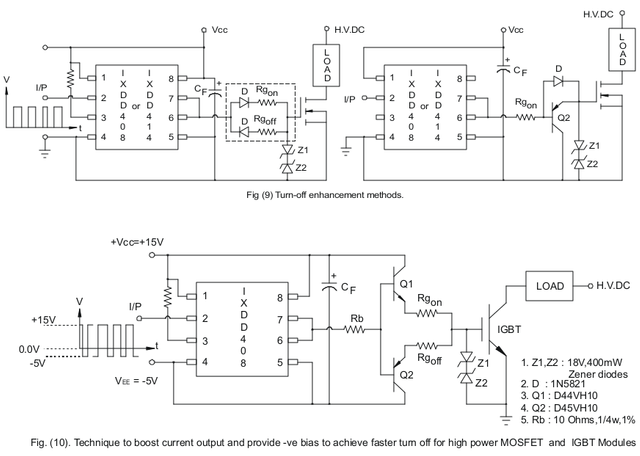
These techniques can also be used for IGBTs or Insulated Gate Bipolar Transistors which have some very interesting properties:
An insulated-gate bipolar transistor (IGBT) is a three-terminal power semiconductor device primarily used as an electronic switch which, as it was developed, came to combine high efficiency and fast switching. It switches electric power in many modern appliances: variable-frequency drives (VFDs), electric cars, trains, variable speed refrigerators, lamp ballasts, air-conditioners and even stereo systems with switching amplifiers. Since it is designed to turn on and off rapidly, amplifiers that use it often synthesize complex waveforms with pulse-width modulation and low-pass filters. In switching applications modern devices feature pulse repetition rates well into the ultrasonic range—frequencies which are at least ten times the highest audio frequency handled by the device when used as an analog audio amplifier.
The IGBT combines the simple gate-drive characteristics of MOSFETs with the high-current and low-saturation-voltage capability of bipolar transistors. The IGBT combines an isolated-gate FET for the control input and a bipolar power transistor as a switch in a single device. The IGBT is used in medium- to high-power applications like switched-mode power supplies, traction motor control and induction heating. Large IGBT modules typically consist of many devices in parallel and can have very high current-handling capabilities in the order of hundreds of amperes with blocking voltages of 6000 V, equating to powers of hundreds of kilowatts.
The first-generation IGBTs of the 1980s and early 1990s were prone to failure through effects such as latchup (in which the device will not turn off as long as current is flowing) and secondary breakdown (in which a localized hotspot in the device goes into thermal runaway and burns the device out at high currents). Second-generation devices were much improved. The current third-generation IGBTs are even better, with speed rivaling MOSFETs, and excellent ruggedness and tolerance of overloads. Extremely high pulse ratings of second- and third-generation devices also make them useful for generating large power pulses in areas including particle and plasma physics, where they are starting to supersede older devices such as thyratrons and triggered spark gaps. High pulse ratings and low prices on the surplus market also make them attractive to the high-voltage hobbyists for controlling large amounts of power to drive devices such as solid-state Tesla coils and coilguns.
Since Hackenberger employed both thyratrons and triggered spark gaps (Ignitrons), albeit in his engine, and since IGBTs have an excellent ruggedness, the use of IGBTs should definitely be considered for our application. And of course all the above techniques should also be considered in the design of Bedini SG circuits as well as Tesla Switch circuits, because it is very likely that it is these spikes which make it possible to use an electrolytic capacitor or a battery to extract energy out of the vacuum, energy which comes for free.
The bowels of the CHPS
After all the above background information, it is finally time to reveal the schematic of the "Blue Engine Power Supply" from 1979 as far as Mark has been able to reconstruct:
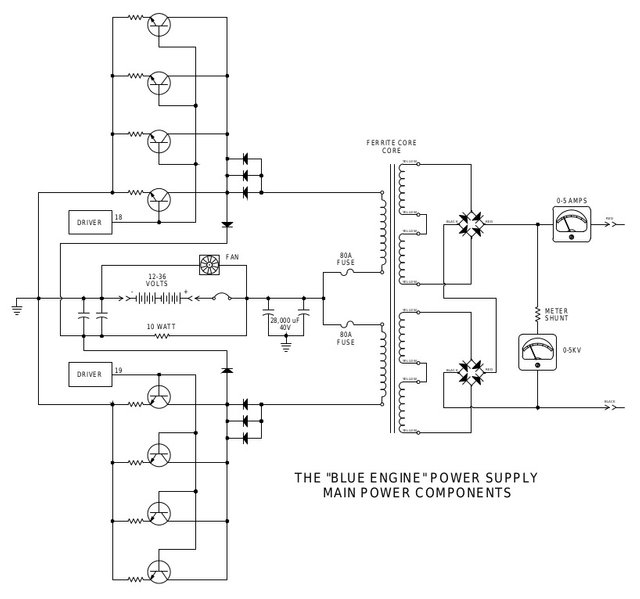
I received this schematic without knowing anything about the CHPS, except that it had two primary windings, just like Matt's Tesla Switch. I immediately recognized the similarity between this schematic and the sketch I made just a day before. I noted that the two BEMF recovery diodes were drawn the wrong way, which I corrected in the above image.
It is also very similar to a basic inverter circuit, which uses the same basic topology as in what Hackenberger called his "E.M.S. inverter":
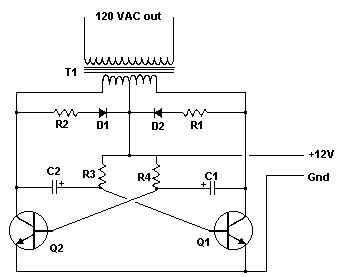
When we compare this basic inverter circuit with a solid state school girl (SSSG) circuit, the CHPS and my sketch above, then we are essentially looking at a dual Bedini SSSG circuit, which is driven back and forth in order to create an alternating magnetic field inside the core, so you can tap A.C. current from the secondary. What basically has to be changed to the basic inverter schematic just above is to remove diodes D1 and D1, which are short-cutting any BEMF spike, and redirect the output of these diode to a circuit which can make use of these BEMF spikes.
In other words: all we really need to do is to apply a twin SSSG circuit to drive this basic inverter circuit, instead of short-cutting the BEMF spikes in the primaries.
While that is the principle, there are quite a lot of details to consider, such as the use of techniques for fast off-switching of the transistor, etc. It should also be noted that the CHPS Mark's schematic is based on has been tampered with and we only have some photographs of it, but I think it should be possible to develop a replication by experimenting with the concepts covered so far.
One of the first design choices we will have to make is whether or not to use a tapped primary, or to really split up the two driving sections as much as possible. The CHPS schematic suggests it is possible to use tapped primary, provided you feed the BEMF spike to an (electrolytic) capacitor which is not directly connected to the battery. In the CHPS, there is a 10 Watt resistor of unknown resistance and there also appears to be a third, unused primary in the transformer. Since it would make sense to use a choke coil instead of a resistor, it could be that Hackenberger used that extra primary for that purpose, which may or may not have a positive effect. In the following schematic, I've drawn a tapped primary and a choke coil, which may or may not be on the same core:
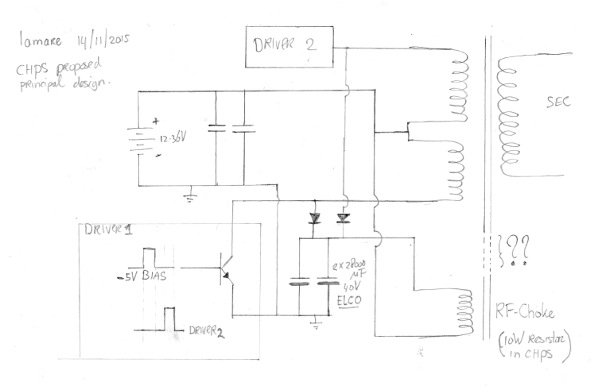
I guess if you were to put it on the same core, you would need some diodes or perhaps a bridge rectifier, which is something I have to take into further consideration. It does seem, though, that the E.M.S. converter started as a system with two batteries and was eventually developed into a system which could do with one battery. In the photo's, I can see only two diodes directly connected to the collectors of the transistors. The other one is isolated and a third may have been moved away from it's original location.
Final notes
This is a work in progress. So far, we have covered the basic theory as well as some practical considerations for designing a replication of the CHPS. However, I would propose to perform experiments to confirm or reject the basic idea first, before attempting to build replications.
Since the basic idea is that an otherwise normal electrolytic capacitor can be brought into a state whereby it converts ZPE into usable electric power, our first step would be to study this effect in detail. I will discuss this in another post later.
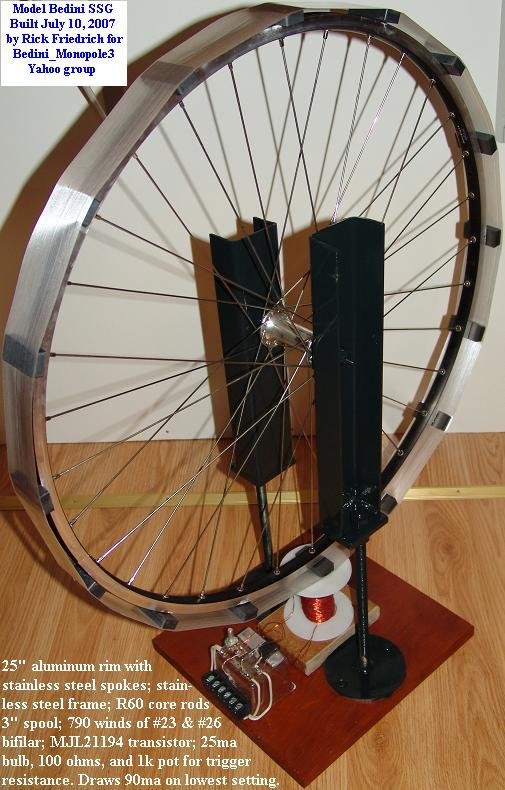
Hi! I am a content-detection robot. This post is to help manual curators; I have NOT flagged you.
Here is similar content:
http://www.tuks.nl/wiki/index.php/Main/ColeHackenbergerPowerSupply
Downvoting a post can decrease pending rewards and make it less visible. Common reasons:
Submit
Yes, that is my site. Will make back-link here.
Downvoting a post can decrease pending rewards and make it less visible. Common reasons:
Submit
Fri, 07 Oct 2016 21:42:10 +0000
http://www.tuks.nl/wiki/index.php/Main/ColeHackenbergerPowerSupply
Time is on my beagle. Seems to run 2 hours behind.
Downvoting a post can decrease pending rewards and make it less visible. Common reasons:
Submit
To Quote your post
Unfortunately, because the spark gap the device employed (to tap radiant energy) caused serious radio and communications interference, the Federal Communications Commission ordered him to stop
Unquote
By that logic every welding shop in the US should be shut down. An arc welder is a really, really BIG spark-gap device. And yet...we have welding shops. But WAIT...not only shops but portables some rather large. The ship builders of the Gulf Coast of Louisiana use portable welding units mounted on dually pickups that drive to the site to work, then drive home at night.
Right there in front of god and everyone...and the FCC.
I'm a former Electronic Technical from ten years in the AirForce. (AFSC 30650 by the old style of reckoning....no idea what they call it now). I say that to indicate that I have some small experience in things electronic.
May I gently suggest that you educate yourself in regard to electronics, physics, and thermodynamics?
I'd rate your article's content.
Credibility= lo.
Downvoting a post can decrease pending rewards and make it less visible. Common reasons:
Submit
@everittdmickey, You've commented:
By your logic, you seem to think you've dismissed the @lamare quote. Unfortunately, governments and their myriad minion agencies are not driven by logic.
@lamare is quoting here from an article published in 2010 by Sterling Allen. The quote asserts one thing; your statement another. At this point, I can only be agnostic about this. I must reserve judgement because neither of you have presented evidence as to what the FCC did - or did not - do in response to operation of the EV Gray motor.
I must confess, however, that as a long time observer of the perfidy of the federal government and its agencies, I would personally find it much easier to accept Allen's statement than your logical conclusion based on the existence of arc welders; unlike "free energy," welding technology is not a threat to the monied powers.
Logically speaking, your burden of proof is also much greater; in order for you to prove that the FCC did not order Gray to stand down, you would have to produce an exhaustive history of the FCC's actions during that time period. Good luck with that! ;)
@lamare, just a suggestion that you may want to re-format your quotations with a Markdown block quote in order to clarify that you have pulled in a paragraph from somewhere else... ;)
Cheers to both of you! Play nice.
Downvoting a post can decrease pending rewards and make it less visible. Common reasons:
Submit
You can take a horse to water.
But you can't make him drink
There is nothing that can be done for the willfully ignorant.
I'm done here.
Seeya.
Downvoting a post can decrease pending rewards and make it less visible. Common reasons:
Submit
The difference between Gray's spark gap and a welder is....a welder isn't making 100's of welds in a second for extended periods of time. You are obviously ignorant to spark gap transmitters used in the early days of radio? ? And I would suggest to you, to look into the difference between closed loop systems, and open loop systems in regards to thermodynamic laws, along with heat pumps with COP great than one. The main problem here, is you haven't been taught that there is energy in the "nothing" that can be gated into these systems. Sharp gradients are known to 'violate' laws in mainstream science:
"Kondepudi and Prigogine list several areas already known and recognized to violate the second law of thermodynamics. These areas include (i) rarefied media, where the local equilibrium concept fails, (ii) strong gradients , and (iii) long-lived memory effects in materials."
http://pubs.rsc.org/en/content/chapterhtml/2015/bk9781782620242-00001?isbn=978-1-78262-024-2
Downvoting a post can decrease pending rewards and make it less visible. Common reasons:
Submit
What you refer to are the conclusions c.q. proposals from Mark McKay, who investigated and collected all the evidence he could get his hands on. Quite a lot of it can be found at my site.
This is basically his best bet on what has probably happened. While this does not mean it is 100% guaranteed to be accurate, it does suggest the device employed radio frequency oscillations within the engine itself, which is totally unlike what you would do with a welder, whereby one is mainly interested in driving large currents trough the arc in order to melt metal.
Arc gaps can also be used in ** RF oscillators**, when used in their negative resistance area of operation. This is a technique dating back to the earlier 1900s. See the links in my article where I wrote:
So, IMHO the conclusion that there cannot have been problems with the FCC is unwarranted, because the Gray engine probably utilized radio frequency oscillations, unlike what is done in welding units.
Please note that the theory proposed in this article does not address Gray's engine itself, but the power supply unit which could also be used stand-alone. So, the data about the engine itself is meant to provide a historical context rather than to analyze or describe the working principles employed in the engine itself.
Downvoting a post can decrease pending rewards and make it less visible. Common reasons:
Submit
@everittdmickey,
You wrote:
I hope to have provided enough interesting "food for thought" to make clear that the argument that my point of view in some way is "willfully ignorant", would probably not be able to withstand proper scrutiny.
So, here's your water. It's free for the taking.....
Downvoting a post can decrease pending rewards and make it less visible. Common reasons:
Submit
Sorry for the, ahem, late reply.
Arcs always give of quite a lot of RF radiation, but there is a difference between welding and an arc-gap oscillator, as was common during the early years of the 19th century and was kown as the Poulsen arc converter:
https://en.wikipedia.org/wiki/Arc_converter
Quite interesting to study, they use the negative resistance area of operation of an arc gap in order to sustain a continuous oscillation, which were later replaced by vacuum tube oscillators.
Negative resistance oscillators are still applied to day, for instance using the so-called "lambda diode":
https://en.wikipedia.org/wiki/Lambda_diode
This article was about the power supply, though, and not so much about the motor itself, although I do suspect RF oscillations of the motor coils may very well have been used. I don't know, that's just a guess.
Downvoting a post can decrease pending rewards and make it less visible. Common reasons:
Submit
Great Article ! Hi could you please upvote this new Selfrunner Free Energy Device ?
Many thanks. Regards, Stefan.
https://steemit.com/technology/@overunitydotcom/newselfrunner-free-energy-device-shown-1544604939241
Downvoting a post can decrease pending rewards and make it less visible. Common reasons:
Submit
It took me three hours to read and process the content. It is to dense to be posted in one article.
Up voted and follow. I want to see more related post where you could explain details of this technology. For me, is the first time hear about it, and I am physicist that work in alternatives energy resources. I really interested to read a lot about it, and it seems you know all the basic theory to teach us.
I will be waiting for your next post.
Congratulations.
Downvoting a post can decrease pending rewards and make it less visible. Common reasons:
Submit
@quigua :
Yes, there is a lot of info in this article and a lot of links for follow up study. For a good understanding of all of this, it is advisable to also consider an aetheric "theory of everything" , a solid theoretic basis Einstein has been unable to formulate.
Further, I posted these theories in this shape here, because it will be entered in the blockchain and will thus be preserved for the future, pretty much no matter what. There is a lot of work to do still, and the dense information concentrated here pretty much guarantees there is no way to sensor this information, we have all the time in the world to expand on this together and create a better future for all mankind.
Namaste,
@lamare
Downvoting a post can decrease pending rewards and make it less visible. Common reasons:
Submit
@lamare,
Thanks for this excellent post. It pulls together a lot of things that I've read about, thought about, and wondered about.
I've recently been watching Rick Friedrich's videos and looking at his PDFs discussing "open, loving circuits," and I hope to be doing some experimentation in this area when I get some time and space. Meanwhile, I look forward to hearing more from you as you work on this! ;)
I'll once more mention that you might want to use Markdown block quotes in those areas where you are quoting from another site -- like this:
Just for the sake of making things a little clearer for your readers.
Rock on! :)
Downvoting a post can decrease pending rewards and make it less visible. Common reasons:
Submit
creatr, maybe this will help you too:
Downvoting a post can decrease pending rewards and make it less visible. Common reasons:
Submit
Hello, @davyoneness,
Very nice to "meet you" here on Steemit. Thank you for this video link. I've read and admired Bedini's work for many years, and mourned his passing.
I've visited your blog and read the two articles you've published so far. It's very clear that we have a lot in common, both in our "mental wiring" and in our interests. I can see that you seem to have carried your studies and experiments considerably further than I've been able to do yet.
In any case, I look forward to learning from you, and wish you the best here on Steemit.
I also want to bring @mage00000 to your attention. He has done extensive studies of Tesla and his writings, and has been working on replicating Tesla's results.
Cheers!
😄😇😄

Downvoting a post can decrease pending rewards and make it less visible. Common reasons:
Submit
Thank you for your kind words. I look forward to sharing more. I came across @mage00000 work on here already and added him already and look forward to more
Downvoting a post can decrease pending rewards and make it less visible. Common reasons:
Submit
Thanks @creatr
The script on my site putting out the markdown is not perfect. Updated the quotes to block quotes.
Downvoting a post can decrease pending rewards and make it less visible. Common reasons:
Submit
Leuk!
Nice seeing you here!
Let's connect!
Downvoting a post can decrease pending rewards and make it less visible. Common reasons:
Submit
Glad to see another Bedini researcher on here! Hope you follow me too!
Downvoting a post can decrease pending rewards and make it less visible. Common reasons:
Submit